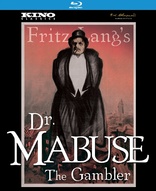Dr. Mabuse: The Gambler Blu-ray Movie
HomeDr. Mabuse: The Gambler Blu-ray Movie 
Dr. Mabuse, der Spieler - Ein Bild der ZeitKino Lorber | 1922 | 270 min | Not rated | Sep 13, 2016
Movie rating
7.7 | / 10 |
Blu-ray rating
| Users | 0.0 | |
| Reviewer | 3.5 | |
| Overall | 3.5 |
Overview
Dr. Mabuse: The Gambler (1922)
Dr. Mabuse the Gambler (German: Dr. Mabuse, der Spieler) is the first film in the Dr. Mabuse series, about the character Doctor Mabuse who featured in the novels of Norbert Jacques. It was directed by Fritz Lang and released in 1922. The film is silent and filmed mostly 16 frames per second. It would be followed by The Testament of Dr. Mabuse (1933) and The Thousand Eyes of Dr. Mabuse (1960). It is about four hours long and divided into two parts: Der große Spieler: Ein Bild der Zeit and Inferno: Ein Spiel von Menschen unserer Zeit. The title, Dr. Mabuse, der Spieler, is ambiguous. Der Spieler means the player in German, and can be translated as the gambler, the actor, or the puppeteer. Dr. Mabuse, who disguises, plays with emotions and tricks other people, is probably all of them in some sense. The film is included in the book 1001 Movies You Must See Before You Die, being the first of five Lang films to be entered
Starring: Rudolf Klein-Rogge, Alfred Abel, Bernhard Goetzke, Paul Richter, Georg JohnDirector: Fritz Lang
| Foreign | Uncertain |
| Drama | Uncertain |
| Mystery | Uncertain |
| Crime | Uncertain |
| Thriller | Uncertain |
Specifications
Video
Video codec: MPEG-4 AVC
Video resolution: 1080p
Aspect ratio: 1.33:1
Original aspect ratio: 1.33:1
Audio
Music: LPCM 2.0
Subtitles
English
Discs
Blu-ray Disc
Two-disc set (2 BDs)
Playback
Region A (locked)
Review
Rating summary
| Movie | 5.0 | |
| Video | 3.5 | |
| Audio | 3.5 | |
| Extras | 1.5 | |
| Overall | 3.5 |
Dr. Mabuse: The Gambler Blu-ray Movie Review
One of cinema's most notorious supercriminals...
Reviewed by Dr. Stephen Larson October 16, 2016Fritz Lang is one of the very few directors to have created several magnum opuses early in his career. With no less than ten features to his credit
during the twenties, this was a particularly fruitful decade for the Austrian-German filmmaker. Due to their long length, some of Lang's works had
to be broken up into two parts or released individually. They boasted harsh contrasts in light and dark, magnificent sets, as well as wide and
panoramic camera shots. The hugely ambitious Dr. Mabuse: The Gambler (Dr. Mabuse, der Spieler, 1922) is Lang's second epic, a
four-and-a-half-hour social portrait of urbanity in post-World War I Germany. According to the writer John Stanley, critics who reviewed Lang's
two-part film in 1922 read the onscreen action as an allegory for the strikes, riots, and street fighting besetting the nation. Inflation was also at a
then-record high and Lang uses his central antagonist, Dr. Mabuse (Rudolf Klein-Rogge), as the criminal mastermind for the Weimar Republic's
economic malaise. Note that this review includes spoilers.
Lang and his co-screenwriter Thea von Harbou divide their work into two parts. "Part I: Dr. Mabuse, the Great Gambler-A Portrait of Our Time"
opens with Dr. Mabuse in his lair fidgeting through a deck of cards with faces of people he hopes to bring down through his diabolical schemes.
Mabuse makes an arrangement to have a covert trade contract pilfered, which sees the value of the company's stock drop precipitously. Mabuse
also attends the opulent Follies Bergere where Cara Carozza (Aud Egede-Nissen) dances. In a highly cinematic sequence, Mabuse successfully
hypnotizes the young millionaire, Edgar Hull (Paul Richter), who goes to a gambling den and loses substantially to Mabuse (appearing in
disguise). The next day when he traverses to Mabuse's hotel to pay his gambling debt, Hull meets Cara as Mabuse had planned, and falls in love
with her. Hull then meets Chief Inspector Norbert von Wenck (Bernhard Goetzke), who is looking into the private gambling clubs. Wenck
conjectures that the two individuals who have won bets from the unsuspecting Hull are essentially the same person, and that Cara has become
involved in the swindle. Wenck visits a club and is nearly hypnotized by Mabuse in disguise. He also meets the Countess Told (Gertrude Welcker)
and is impressed by her. A chain of events ensues with Cara getting arrested and the kidnapping of the Countess by Mabuse.
In "Part II: An Inferno, a Play of People in Our Time," Von Wenck's office is bombed by Mabuse's accomplices. Mabuse makes Count Told
emotionally unstable. Von Wenck questions Told's psychiatrist (who is actually Doctor Mabuse in disguise) about Told's whereabouts and the doctor
suggests to Wenck that he attend a public performance to be given by Sandor Weltmann, a hypnotist. Weltmann, who is actually Mabuse in
another disguise, hypnotizes Wenck into getting into his car and making a suicide attempt. Using tight editing and rapid cross-cutting, the last
section of the film incorporates tropes of the American gangster film (which would flourish in the thirties) and the Western.
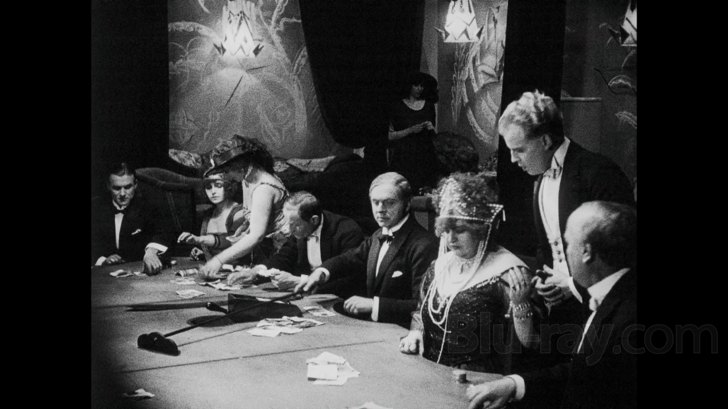
The gamblers' den.
In Dr. Mabuse: The Gambler, Lang creates a cinematic oasis of avaricious thieves, prostitutes, and lawmen. Lang's repertoire is on full display here through his ingenious use of decorative architecture, match dissolves, and low-key lighting. The film is a logical extension of Destiny (1921) in the same vein that the evil principal appears in different disguises to tempt humankind to either commit bad deeds or inflict a fatal blow. Dr. Mabuse is a long film and I would recommend viewers to take a fifteen or thirty-minute break between the two parts to absorb all that they have seen.
Dr. Mabuse: The Gambler Blu-ray Movie, Video Quality 
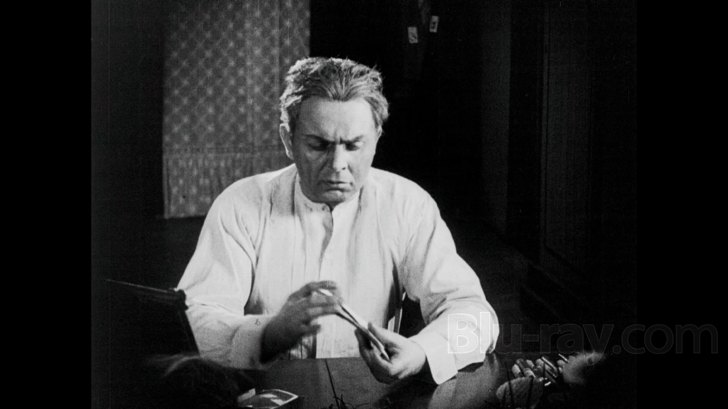
Dr. Mabuse: The Gambler makes its U.S. debut on Blu-ray courtesy of Kino Lorber. The label's subsidiary, Kino Classics, has placed each
part on its own BD-50. This composite print appears to be struck from the same 2K digital restoration that my colleague, Dr. Svet Atanasov,
reviewed three years ago on a deluxe edition
released by Eureka Entertainment. For those unfamiliar with Dr. Mabuse's restoration, two versions of Lang's film were brought
together in 1991 thanks to the Munich Film Museum and its director, Enno Patalas. One derived from Gosfilmofond (Moscow) and the other from
Bundesarchiv/Filmarchiv (Berlin). The 34th San Francisco International Film Festival, in conjunction with the Goethe Institut, presented this
compilation to U.S. audiences in spring, 1991. As the opening title card on Disc One states, the Friedrich-Wilhelm-Murnau-Stiftung conducted a
photochemical restoration in 2000, utilizing as its basis the original camera negative of the German distribution version and a negative of the export
version.
Dr. Mabuse: The Gambler appears in its original theatrical aspect ratio of 1.33:1. The presentation of the film's reconstruction is presumably
a duplicate of Kino's 2006 "Restored Authorized Edition" but with a notable difference. That DVD did not have a proper PAL to NTSC conversion,
resulting in combing during scenes of fast movement. This Blu-ray does not appear to have any ghosting while characters are in motion. The higher
resolution enhances individual details in the frame and brings out the dense texture of the monochromatic images. There are nice layers of grain that
permeate the image, making it more film-like. However, the chroma-like effects that my fellow reviewer noted on the Masters of Cinema Region B
disc are present here too. Furthermore, sections of the film look culled from an analog tape source. Diagonal wavy lines cross the image which
become a distraction. Without compromising the organic look of the film, Kino could have done more to minimize this deficiency in the source
material. Granted, the movie is ninety-four years old but this anomaly stands out more than other flaws in the transfer. Contrast is solid but can be
erratic in brightly lit scenes. The average video bitrate on both discs is 26.49 Mbps, which lags behind the 34.82 Mbps on Eureka's two BD-50s.
Compression is not subar on Kino's but with the movie spread over two dual-layer discs, a maximum bitrate would have been desirable.
The original German intertitles are preserved and any missing, damaged, or incomplete titles have been rectified and appended with censorship
documentation. Kino provides optional white English intertitles which appear near the bottom of the screen in a sans serif font with a relatively tall
typeface. The placement is usually ideal but in cases where the German characters appear at the bottom and two translated lines are required, the
electronically generated titles stack on top of the originals (see Screenshot #20).
Dr. Mabuse: The Gambler Blu-ray Movie, Audio Quality 
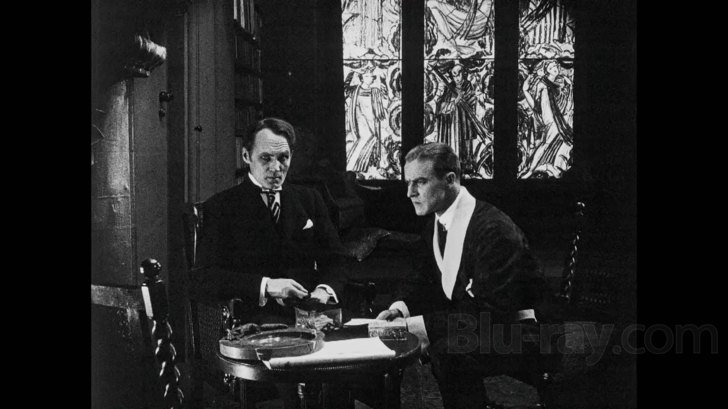
Kino provides only one audio track on each disc: a LPCM 2.0 sound track featuring music by the late composer Aljoscha Zimmermann. The score intersperses a piano trio, dour violin, and xylophone which supply a highly suitable accompaniment to the film's atmosphere, the characters' shifting moods, and the dramatic scenes. Zimmermann studied the original scores written for Lang's other silent works and while Dr. Mabuse: The Gambler did have an original score, one would be hard-pressed to find a more appropriate one. The instrumentation is heard primarily across the center and front channels. Kino encoded the recording at 1536 kbps with a bit depth of 16. Eureka had already advanced those technical specs with 2304 kbps and a bit depth of 24. Even still, both labels missed a chance at giving Zimmermann's remarkable score a 5.1 mix. (Transit Films/Madman Entertainment's two-disc Region 4 PAL release of the film [part of their Director's Suite series] gave Zimmermann's music its own Dolby Digital 5.1 track.)
Dr. Mabuse: The Gambler Blu-ray Movie, Special Features and Extras 

- The Story Behind Dr. Mabuse (52:33, 1080i upconvert) - this documentary on the Dr. Mabuse: The Gambler appeared on Kino's 2006 DVD and later Eureka's 2013 Blu-ray. The doc is divided into three featurettes which can be played individually on the second disc. They are presented in German with embedded English subtitles. The Music of Mabuse (13:00) shows Zimmermann sitting at his piano playing themes he came up with and explaining his scoring methodology for Lang's moral universe. Norbert Jacques, the literary inventor of Dr. Mabuse (9:37) features interview snippets with historian Michael Farin who discusses Jacques's novels and his creation of the Mabuse character. Mabuse's Motives (29:56) is the most substantial featurette examining the film's characterizations, themes, and messages. It features archival interviews with Fritz Lang.
The Kino Blu-ray drops the seventeen stills and lobby cards which appeared on its DVD. The Blu-ray also loses David Kalat's feature-length audio commentary that Eureka Entertainment ported over from Image Entertainment's 2001 two-disc set.
Dr. Mabuse: The Gambler Blu-ray Movie, Overall Score and Recommendation 
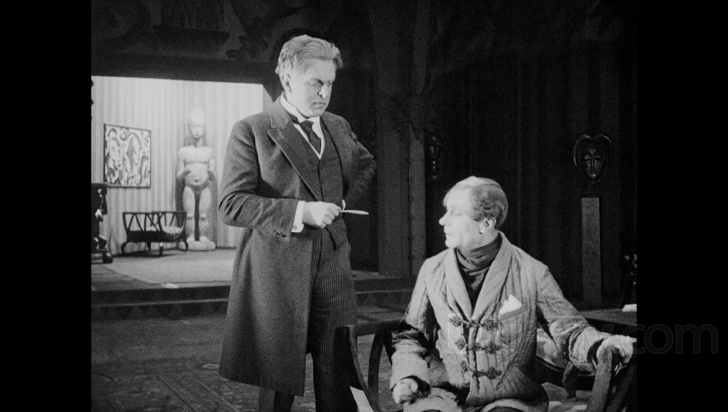
Fritz Lang's first classic Dr. Mabuse film makes it U.S. premiere with an acceptable transfer that provides a decent viewing experience. The Kino edition is inferior to its UK counterpart in terms of authoring/compression, transfer, and supplements (e.g., Eureka's booklet, commentary). Nonetheless, the Kino comes RECOMMENDED for consumers residing in Region A territories. Hopefully, Lang's The Testament of Dr. Mabuse (1933) and The 1,000 Eyes of Dr. Mabuse (1960) will receive special edition Blu-rays in the U.S. soon.
Similar titles
Similar titles you might also like

Four Around the Woman
1921

Harakiri
1919

Woman in the Moon
Frau im Mond
1929

Spies
Spione
1928

The Plague of Florence
Die Pest in Florenz
1919

Elite Squad: The Enemy Within
Tropa de Elite 2: O Inimigo Agora É Outro
2010

Black Coal, Thin Ice
白日焰火 / Bai ri yan huo
2014

Destiny
Der müde Tod
1921

The Girl with the Dragon Tattoo
Män som hatar kvinnor
2009

Mother
마더 / Madeo
2009

High and Low 4K
天国と地獄 / Tengoku to jigoku
1963

Berlin Alexanderplatz
1980

36th Precinct
36 quai des Orfèvres
2004

The Club
El Club
2015

A Touch of Sin
天注定 / Tian zhu ding
2013

Holy Spider
2022

The Thousand Eyes of Dr. Mabuse
Die 1000 Augen des Dr. Mabuse / Masters of Cinema
1960

Female Prisoner Scorpion: #701's Grudge Song
1973

The Third Murder
三度目の殺人
2017

Quai des Orfèvres
1947
